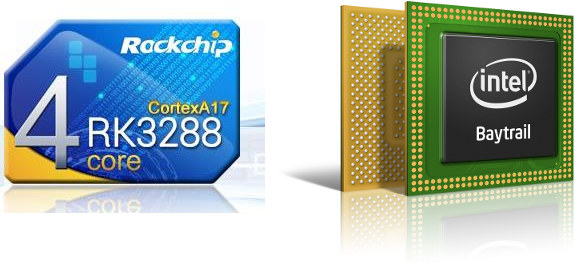Most ARM mini PCs run Android, while mini PCs based on Intel Atom Z3735F currently all ship with Windows 8.1, so it makes comparison difficult. But since Linuxium posted triple boot instructions (Ubuntu, Android, Windows 10) for MeegoPad T01, he’s also run Antutu 5.6 on the platform, so we’ve got a comparison point. The Android image used in the Intel platform is Android-x86, and may not have been optimized for Bay Trail yet, so even though the comparison may not be perfect, it could still be interesting to find out the strengths and weaknesses of the Intel processor, against one of the fastest ARM processor found in mini PCs: Rockchip RK3288.
 I’ll use the Antutu 5.3 score I got with Open Hour Chameleon as a reference point.
I’ll use the Antutu 5.3 score I got with Open Hour Chameleon as a reference point.
| Rockchip RK3288 | Intel Atom Z3735F | Delta | |
| CPU | Quad core Cortex A17 @ 2.0 GHz | Quad core @ 1.33 GHz (Burst 1.83GHz) | |
| GPU | ARM Mali-T764 | Intel HD Graphics Gen 7 | |
| Antutu 5.x | |||
| Overall | 36525 | 29851 | -18.27% |
| Multitask | 5906 | 3947 | -33.17% |
| Runtime | 2039 | 2064 | 1.23% |
| RAM Ops | 2487 | 2158 | -13.23% |
| RAM Speed | 2985 | 3281 | 9.92% |
| CPU Integer (multi-thread) | 2414 | 3035 | 25.72% |
| CPU float-point (multi-thread) | 3515 | 2984 | -15.11% |
| CPU Integer (single thread) | 1455 | 1572 | 8.04% |
| CPU float-point (single thread) | 1893 | 1696 | -10.41% |
| 2D Graphics (1920×1080) | 1447 | 1346 | -6.98% |
| 3D Graphics (1920×1080) | 11108 | 5904 | -46.85% |
It would have been nice to have data from other benchmarks too, but I could not find results yet. The red results indicate the Intel SoC is slower than the Rockchip one, and the green ones where the Intel SoC outperforms. 3D graphics is where the Intel GPU shows its limitation against the Mali-T764, which according to Antutu is about twice as fast. For some reasons multi-tasking shows a relatively poor result too. Z3735F has significantly better integer performance, but floating point is not as good. But overall performance between the two should not be that noticeable for end users, except possibly for 3D games.

Jean-Luc started CNX Software in 2010 as a part-time endeavor, before quitting his job as a software engineering manager, and starting to write daily news, and reviews full time later in 2011.
Support CNX Software! Donate via cryptocurrencies, become a Patron on Patreon, or purchase goods on Amazon or Aliexpress




